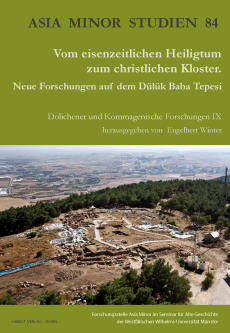Ancient Finds from South-Eastern Turkey
New Research Findings on the Cult of the Roman God Iuppiter Dolichenus

A new publication, which is edited by classical scholar Prof. Dr. Engelbert Winter from the Cluster of Excellence “Religion and Politics”, presents new research findings on archaeological finds from the temple of the god Iuppiter Dolichenus in south-eastern Turkey. It shows finds from all eras of the 2,000-year-old history where the cult took place, the researcher explains. Under his supervision, the Research Department of Asia Minor of Münster University has been excavating the main temple of this significant Roman deity with the support of the German Research Foundation (Deutsche Forschungsgemeinschaft, DFG) since 2001. The book offers insights into the results of the excavation campaigns from 2013 to 2015. The finds, which were discovered by the excavation team close to the ancient city of Doliche on the present-day border between Turkey and Syria, are pieces made of stone, marble, metal and pottery, faunal remains, bone artefacts and gems as well as inscriptions and sculptures.
“The book makes it possible to sketch a more sophisticated picture of the transformation of Dülük Baba Tepesi as a holy place and give an impetus to the study of material culture and the religious history of ancient northern Syria,” says Prof. Winter. “As the authors show, our work has continuously uncovered new insights on the historical development of the origin of Iuppiter Dolichenus.” During the course of the excavations, it has become apparent that the place has been of supra-regional significance for centuries. “From the early first millennium BC to the Middle Ages, this was an important religious centre.” The temple is situated on the mountain of Dülük Baba Tepesi 1,200 metres high, close to the modern city of Gaziantep. As early as the 9th and 8th century BC, the place was used as a temple, as the archaeologists discovered, and thus is significantly older than what was initially thought.
From Prehistory to Christian Monastery
The anthology is called “From the Iron Age Sanctuary to Christian Monastery: New Research on Dülük Baba Tepesi”. In 17 articles, the book focuses on the finds from the various periods of usage of the summit plateau – from a prehistoric station up to a Christian monastery. Furthermore, the publication contains comprehensive results on the importance of the Iron Age temple and on constructional engineering in the Hellenistic-Roman period. Engelbert Winter: “Especially the interpretation of the finds from the Roman temple enables further insights, not only on the topography and architectural history of the imperial sanctuary, but also on cult practice and on questions of the continuity of local religious concepts of the Iron Age in the Roman era.” This is a central aspect of the research project B2-20, which is headed by Prof. Winter at the Cluster of Excellence and closely connected with the excavation. The project is called “Media Representation and ‘Religious Market’: Visibility, Self-Expression and Reception of Syriac Cults in the Western Imperium Romanum”. Its focus is on the transformation of local cults into imperial religions. (dak/vvm)

